Guam
| Territory of Guam Guåhån |
||||||
|---|---|---|---|---|---|---|
|
||||||
| Anthem: "Fanohge Chamoru" "Stand Ye Guamanians" "The Star-Spangled Banner" |
||||||
_(Polynesia_centered).svg.png) |
||||||
_-_GUM_-_UNOCHA.svg.png) |
||||||
| Status | Unincorporated and organized territory | |||||
| Capital | Hagåtña | |||||
| Largest city | Dededo | |||||
| Official languages | ||||||
| Ethnic groups (2015[1]) | ||||||
| Demonym | Guamanian | |||||
| Sovereign state | United States | |||||
| Government | Territorial presidential constitutional republic | |||||
| • | President | Barack Obama (D) | ||||
| • | Governor | Eddie Calvo (R) | ||||
| • | Lt. Governor | Raymond Tenorio (R) | ||||
| • | Delegate | Madeleine Bordallo (D) | ||||
| Legislature | Legislature of Guam | |||||
| Area | ||||||
| • | Total | 544 km2 (n/a) 210 sq mi |
||||
| • | Water (%) | negligible | ||||
| Population | ||||||
| • | 2016 estimate | 162,742[1] (n/a) | ||||
| • | 2010 census | 159,358[1] | ||||
| • | Density | 299/km2 (n/a) 775/sq mi |
||||
| GDP (PPP) | 2013 estimate | |||||
| • | Total | $4.88 billion[1] (n/a) | ||||
| • | Per capita | $30,500[1] (n/a) | ||||
| HDI (2008) | very high |
|||||
| Currency | United States dollar (USD) | |||||
| Time zone | Chamorro Standard Time (UTC+10) | |||||
| Calling code | +1-671 | |||||
| ISO 3166 code | GU | |||||
| Internet TLD | .gu | |||||
| Website Guam.gov |
||||||
Guam (![]() i/ˈɡwɑːm/ or /ˈɡwɒm/; Chamorro: Guåhån [ˈɡʷɑhɑn]; formally the Territory of Guam) is an unincorporated and organized territory of the United States. Located in the western Pacific Ocean, Guam is one of five American territories with an established civilian government.[3][4] The capital city is Hagåtña, and the most populous city is Dededo. In 2015, 161,785 people resided on Guam. Guamanians are American citizens by birth. Guam has an area of 544 km2 (210 sq mi) and a population density of 297/km² (770/sq mi). It is the largest and southernmost of the Mariana Islands, and the largest island in Micronesia. Among its municipalities, Mongmong-Toto-Maite has the highest density at 1,425/km² (3,691/sq mi), whereas Inarajan and Umatac have the lowest density at 47/km² (119/sq mi). The highest point is Mount Lamlam at 406 meters (1,332 ft) above sea level.
i/ˈɡwɑːm/ or /ˈɡwɒm/; Chamorro: Guåhån [ˈɡʷɑhɑn]; formally the Territory of Guam) is an unincorporated and organized territory of the United States. Located in the western Pacific Ocean, Guam is one of five American territories with an established civilian government.[3][4] The capital city is Hagåtña, and the most populous city is Dededo. In 2015, 161,785 people resided on Guam. Guamanians are American citizens by birth. Guam has an area of 544 km2 (210 sq mi) and a population density of 297/km² (770/sq mi). It is the largest and southernmost of the Mariana Islands, and the largest island in Micronesia. Among its municipalities, Mongmong-Toto-Maite has the highest density at 1,425/km² (3,691/sq mi), whereas Inarajan and Umatac have the lowest density at 47/km² (119/sq mi). The highest point is Mount Lamlam at 406 meters (1,332 ft) above sea level.
The Chamorros, Guam's indigenous people, settled the island approximately 4,000 years ago. Portuguese explorer Ferdinand Magellan was the first European to visit the island on March 6, 1521. Guam was colonized in 1668 with settlers, like Diego Luis de San Vitores, a Catholic missionary. Between the 1500s and the 1700s, Guam was an important stopover for the Spanish Manila Galleons. During the Spanish–American War, the United States captured Guam on June 21, 1898. Under the Treaty of Paris, Spain ceded Guam to the United States on December 10, 1898. Guam is among the seventeen Non-Self-Governing Territories of the United Nations.[5]
Before World War II, Guam and three other territories – American Samoa, Hawaii, and the Philippines – were the only American jurisdictions in the Pacific Ocean. On December 7, 1941, hours after the attack on Pearl Harbor, Guam was captured by the Japanese, and was occupied for thirty months. During the occupation, Guamanians were subjected to culture alignment, forced labor, beheadings, rape, and torture.[6][7][8] Guam endured hostilities when American forces recaptured the island on July 21, 1944; Liberation Day commemorates the victory.[9] Since the 1960s, the economy is supported by two industries: tourism and the United States Armed Forces.[10]
History
The original inhabitants of Guam and the Northern Mariana Islands are believed to be descendants of Austronesian people originating from Southeast Asia as early as 2000 BC.[11]:16 They evolved into the Chamorro people.
The ancient-Chamorro society had four classes: chamorri (chiefs), matua (upper class), achaot (middle class), and mana'chang (lower class).[11]:20–21 The matua were located in the coastal villages, which meant they had the best access to fishing grounds, whereas the mana'chang were located in the interior of the island. Matua and mana'chang rarely communicated with each other, and matua often used achaot as intermediaries. There were also "makåhna" (similar to shamans), skilled in healing and medicine. Belief in spirits of ancient Chamorros called "Taotao mo'na" still persists as a remnant of pre-European culture. Their society was organized along matrilineal clans.[11]:21
Latte stones are stone pillars that are found only in the Mariana Islands; and, they are a recent development in Pre-Contact Chamorro society. The latte-stone was used as a foundation on which thatched huts were built.[11]:26 Latte stones consist of a base shaped from limestone called the haligi and with a capstone, or tåsa, made either from a large brain coral or limestone, placed on top.[11]:27–28 A possible source for these stones, the Rota Latte Stone Quarry, was discovered in 1925 on Rota.[11]:28
Magellan's travel to Guam
The first European to travel to Guam was Portuguese navigator Ferdinand Magellan, sailing for the King of Spain, when he sighted the island on March 6, 1521 during his fleet's circumnavigation of the globe.[11]:41–42 When Magellan arrived on Guam, he was greeted by hundreds of small outrigger canoes that appeared to be flying over the water, due to their considerable speed. These outrigger canoes were called Proas, and resulted in Magellan naming Guam Islas de las Velas Latinas ("Islands of the Lateen sails"). Antonio Pigafetta (one of Magellan's original 18) said that the name was the name "Island of Sails", but he also writes that the inhabitants "entered the ships and stole whatever they could lay their hands on", including "the small boat that was fastened to the poop of the flagship."[12]:129 "Those people are poor, but ingenious and very thievish, on account of which we called those three islands Islas de los Ladrones ("Islands of thieves")."[12]:131
Spanish colonization and the Manila galleons
Despite Magellan's visit, Guam was not officially claimed by Spain until January 26, 1565 by General Miguel López de Legazpi.[11]:46 From 1565 to 1815, Guam and the Northern Mariana Islands, the only Spanish outpost in the Pacific Ocean east of the Philippines, was an important resting stop for the Manila galleons, a fleet that covered the Pacific trade route between Acapulco and Manila.[11]:51 To protect these Pacific fleets, Spain built several defensive structures which are still standing today, such as Fort Nuestra Señora de la Soledad in Umatac. It is the biggest single segment of Micronesia, the largest islands between the island of Kyushu (Japan), New Guinea, the Philippines, and the Hawaiian Islands.
Spanish colonization commenced on June 15, 1668 with the arrival of Diego Luis de San Vitores and Pedro Calungsod, who established the first Catholic church.[11]:64 The islands were part of the Spanish East Indies governed from the Philippines, which were in turn part of the Viceroyalty of New Spain based in Mexico City. Other reminders of colonial times include the old Governor's Palace in Plaza de España and the Spanish Bridge, both in Hagatña. Guam's Cathedral Dulce Nombre de Maria was formally opened on February 2, 1669, as was the Royal College of San Juan de Letran.[11]:68 Guam, along with the rest of the Mariana and Caroline Islands, were treated as part of Spain's colony in the Philippines. While Guam's Chamorro culture has indigenous roots, the cultures of both Guam and the Northern Marianas have many similarities with Spanish and Mexican culture due to three centuries of Spanish rule.[10]
Internal conflicts
Intermittent warfare lasting from July 23, 1670 until July 1695, plus the typhoons of 1671 and 1693, and in particular the smallpox epidemic of 1688, reduced the Chamorro population from 50,000 to 10,000 to less than 5,000.[11]:86 Precipitated by the death of Quipuha, and the murder of Father San Vitores and Pedro Calungsod by local rebel chief Matapang, tensions led to a number of conflicts. Captain Juan de Santiago started a campaign to pacify the island, which was continued by the successive commanders of the Spanish forces.[11]:68–74
After his arrival in 1674, Captain Damian de Esplana ordered the arrest of rebels who attacked the population of certain towns. Hostilities eventually led to the destruction of villages such as Chochogo, Pepura, Tumon, Sidia-Aty, Sagua, Nagan and Ninca.[11]:74–75 Starting in June 1676, the first Spanish Governor of Guam, Capt. Francisco de Irrisarri y Vinar controlled internal affairs more strictly than his predecessors in order to curb tensions. He also ordered the construction of schools, roads and other infrastructure.[11]:75–76 Later, Capt. Jose de Quiroga arrived in 1680 and continued some of the development projects started by his predecessors. He also continued the search for the rebels who had assassinated Father San Vitores, resulting in campaigns against the rebels which were hiding out in some islands, eventually leading to the death of Matapang, Hurao and Aguarin.[11]:77–78 Quiroga brought some natives from the northern islands to Guam, ordering the population to live in a few large villages.[11]:78–79 These included Jinapsan, Umatac, Pago, Agat and Inarajan, where he built a number of churches.[11]:79 By July 1695, Quiroga had completed the pacification process in Guam, Rota, Tinian and Aguigan.[11]:85
Expulsion of the Jesuits
On February 26, 1767, Charles III of Spain issued a decree confiscating the property of the Jesuits and banishing them from Spain and her possessions.[11]:101 As a consequence, the Jesuit fathers on Guam departed on November 2, 1769 on the schooner Nuestra Senora de Guadalupe, abandoning their churches, rectories and ranches.[11]:102–103
The arrival of Governor Don Mariano Tobias, on September 15, 1771, brought agricultural reforms, including making land available to the islanders for cultivation, encouraged the development of cattle raising, imported deer and water buffalos from Manila, donkeys and mules from Acapulco, established cotton mills and salt pans, free public schools, and the first Guam militia.[11]:107–109 Later, he was transferred to Manila in June 1774.[11]:113
Post-Napoleonic Era
Following the Napoleonic Wars, many Spanish colonies in the Western Hemisphere had become independent, shifting the economic dependence of Guam from Mexico to the Philippines.[11]:144 Don Francisco Ramon de Villalobos, who became governor in 1831, improved economic conditions including the promotion of rice cultivation and the establishment of a leper hospital.[11]:148–149
Otto von Kotzebue visited the island in November 1817,[11]:127 and Louis de Freycinet in March 1819.[11]:134 Jules Dumont d'Urville made two visits, the first in May 1828.[11]:139 The island became a rest stop for whalers starting in 1823.[11]:145
A devastating typhoon struck the island on August 10, 1848 and then a severe earthquake on January 25, 1849, which resulted in many refugees from the Caroline Islands, victims of the resultant tsunami.[11]:151 After a smallpox epidemic killed 3,644 Guamanians in 1856, Carolinians and Japanese were permitted to settle in the Marianas.[11]:157 Guam received nineteen Filipino prisoners after their failed 1872 Cavite mutiny.[11]:160
Spanish–American War and World War II
The United States occupied the island in the 1898 Spanish–American War, as part of the Treaty of Paris. Guam was transferred to U.S. Navy control on 23 December 1898 by Executive Order 108-A. Guam came to serve as a station for American ships traveling to and from the Philippines, while the Northern Mariana Islands passed to Germany, and then to Japan.[10] A U.S. Navy yard was established at Piti in 1899, and a marine barracks at Sumay in 1901.[13]:13 Following the Philippine–American War, Emilio Aguinaldo and Apolinario Mabini were exiled on Guam in 1901.[14]:vi
A marine seaplane unit was stationed in Guam from 1921 to 1930, the first in the Pacific.[13]:13 Pan American Airways established a seaplane base on the island for its San Francisco-Manila-Hong Kong route, and the Commercial Pacific Cable Company built a telegraph/telephone station in 1903.[13]:15 During World War II, Guam was attacked and invaded by the Empire of Japan on December 8, 1941 shortly after the attack on Pearl Harbor.
The Northern Mariana Islands had become a Japanese protectorate before the war. It was the Chamorros from the Northern Marianas who were brought to Guam to serve as interpreters and in other capacities for the occupying Japanese force. The Guamanian Chamorros were treated as an occupied enemy by the Japanese military. After the war, this would cause resentment between the Guamanian Chamorros and the Chamorros of the Northern Marianas. Guam's Chamorros believed their northern brethren should have been compassionate towards them, whereas having been occupied for over 30 years, the Northern Mariana Chamorros were loyal to Japan.
Guam's Japanese occupation lasted for approximately thirty-one months. During this period, the indigenous people of Guam were subjected to forced labor, family separation, incarceration, execution, concentration camps and forced prostitution. Approximately one thousand people died during the occupation, according to Congressional testimony in 2004. Some historians estimate that war violence killed 10% of Guam's 20,000 population.[15]
The United States returned and fought the Battle of Guam from July 21 to August 10, 1944, to recapture the island from Japanese military occupation. More than 18,000 Japanese were killed as only 485 surrendered. Sergeant Shoichi Yokoi, who surrendered in January 1972, appears to have been the last confirmed Japanese holdout in Guam.[16] The United States also captured and occupied the Northern Marianas.
North Field was established in 1944, and was renamed for Brigadier General James Roy Andersen (1904–1945) as Andersen Air Force Base.
Post-war
After World War II, the Guam Organic Act of 1950 established Guam as an unincorporated organized territory of the United States, provided for the structure of the island's civilian government, and granted the people U.S. citizenship. The Governor of Guam was federally appointed until 1968, when the Guam Elective Governor Act provided for the office's popular election.[17]:242 Since Guam is not a U.S. state, U.S. citizens residing on Guam are not allowed to vote for president and their congressional representative is a non-voting member.[10] They do, however, get to vote for party delegates in presidential primaries.[18]
Vietnam War and later
Andersen Air Force Base played a major role in the Vietnam War. The host unit was later designated the 36th Wing (36 WG), assigned to the Pacific Air Forces (PACAF) Thirteenth Air Force (13AF). In September 2012, 13 AF was inactivated and its functions merged into PACAF.
On August 6, 1997, Guam was the site of the Korean Air Flight 801 aircraft accident. The Boeing 747–300 jetliner was preparing to land when it crashed into a hill, killing 228 of the 254 people on board. Since 1974, about 124 historic sites in Guam have been recognized under the U.S. National Register of Historic Places. Guam temporarily hosted 100,000 Vietnamese refugees in 1975, and 6,600 Kurdish refugees in 1996.[13]:17
Geography
Guam lies between 13.2°N and 13.7°N and between 144.6°E and 145.0°E, and has an area of 212 square miles (549 km2), making it the 32nd largest island of the United States. It is the southernmost and largest island in the Mariana island chain and is also the largest island in Micronesia. This island chain was created by the colliding Pacific and Philippine Sea tectonic plates. Guam is the closest land mass to the Mariana Trench, a deep subduction zone, that lies beside the island chain to the east. Challenger Deep, the deepest surveyed point in the Oceans, is southwest of Guam at 35,797 feet (10,911 meters) deep. The highest point in Guam is Mount Lamlam at an elevation of 1,334 feet (407 meters).[19]
The island of Guam is 30 miles (50 km) long and 4 to 12 miles (6 to 19 km) wide, 3⁄4 the size of Singapore. The island experiences occasional earthquakes due to its location on the western edge of the Pacific Plate and near the Philippine Sea Plate. In recent years, earthquakes with epicenters near Guam have had magnitudes ranging from 5.0 to 8.7. Unlike the Anatahan volcano in the Northern Mariana Islands, Guam is not volcanically active. However, due to its proximity to Anatahan, vog (i.e. volcanic smog) does occasionally affect Guam.[20]
A coral table reef surrounds most of Guam, and the limestone plateau provide the source for most of the island's fresh water. Steep coastal cliffs dominate the north, while the southern end of the island is mountainous, with lower hills in between.[1]
Climate
Guam's climate is characterized as tropical marine moderated by seasonal northeast trade winds. The weather is generally very warm and humid with little seasonal temperature variation. The mean high temperature is 86 °F (30 °C) and mean low is 76 °F (24 °C) with an average annual rainfall of 96 inches (2,180 mm). The dry season runs from December to June. The remaining months (July to November) constitute the rainy season. The months of January and February are considered the coolest months of the year with overnight low temperatures of 70–75 °F (21–24 °C) and low humidity levels. The highest temperature ever recorded in Guam was 96 °F (36 °C) on April 18, 1971 and April 1, 1990, and the lowest temperature ever recorded was 65 °F (18 °C) on February 8, 1973.[21]
Guam is located in Typhoon Alley[22] and it is common for the island to be threatened by tropical storms and possible typhoons during the wet season. The highest risk of typhoons is during September and October. They can, however, occur year-round. The most intense typhoon to pass over Guam recently was Super Typhoon Pongsona, with sustained winds of 144 miles per hour (232 km/h), gusts to 173 miles per hour (278 km/h), which slammed Guam on December 8, 2002, leaving massive destruction.
Since Super Typhoon Pamela in 1976, wooden structures have been largely replaced by concrete structures.[23][24] During the 1980s wooden utility poles began to be replaced by typhoon-resistant concrete and steel poles. After the local Government enforced stricter construction codes, many home and business owners built their structures out of reinforced concrete with installed typhoon shutters.
| Month | Jan | Feb | Mar | Apr | May | Jun | Jul | Aug | Sep | Oct | Nov | Dec | Year |
|---|---|---|---|---|---|---|---|---|---|---|---|---|---|
| Record high °F (°C) | 94 (34) |
93 (34) |
93 (34) |
96 (36) |
94 (34) |
95 (35) |
95 (35) |
94 (34) |
93 (34) |
93 (34) |
92 (33) |
91 (33) |
96 (36) |
| Average high °F (°C) | 84.9 (29.4) |
84.9 (29.4) |
85.8 (29.9) |
87.3 (30.7) |
87.9 (31.1) |
87.9 (31.1) |
87.1 (30.6) |
86.5 (30.3) |
86.7 (30.4) |
86.8 (30.4) |
86.5 (30.3) |
85.6 (29.8) |
86.5 (30.3) |
| Daily mean °F (°C) | 80.2 (26.8) |
79.9 (26.6) |
80.7 (27.1) |
81.9 (27.7) |
82.6 (28.1) |
82.6 (28.1) |
81.9 (27.7) |
81.4 (27.4) |
81.4 (27.4) |
81.7 (27.6) |
81.8 (27.7) |
81.2 (27.3) |
81.4 (27.4) |
| Average low °F (°C) | 75.5 (24.2) |
75.0 (23.9) |
75.6 (24.2) |
76.5 (24.7) |
77.2 (25.1) |
77.4 (25.2) |
76.6 (24.8) |
76.3 (24.6) |
76.2 (24.6) |
76.5 (24.7) |
77.2 (25.1) |
76.8 (24.9) |
76.4 (24.7) |
| Record low °F (°C) | 66 (19) |
65 (18) |
66 (19) |
68 (20) |
70 (21) |
70 (21) |
70 (21) |
70 (21) |
70 (21) |
67 (19) |
68 (20) |
68 (20) |
65 (18) |
| Average precipitation inches (mm) | 4.96 (126) |
4.53 (115.1) |
2.77 (70.4) |
3.58 (90.9) |
4.30 (109.2) |
7.09 (180.1) |
12.14 (308.4) |
17.15 (435.6) |
14.17 (359.9) |
11.80 (299.7) |
9.17 (232.9) |
5.98 (151.9) |
97.64 (2,480.1) |
| Average precipitation days (≥ 0.01 in) | 18.8 | 15.7 | 16.8 | 17.0 | 19.3 | 22.6 | 24.7 | 25.3 | 24.3 | 25.1 | 23.4 | 22.1 | 254.9 |
| Mean monthly sunshine hours | 176.7 | 186.0 | 217.0 | 213.0 | 220.1 | 195.0 | 155.0 | 142.6 | 132.0 | 133.3 | 135.0 | 142.6 | 2,048.3 |
| Source #1: NOAA (normals)[25] | |||||||||||||
| Source #2: Hong Kong Observatory (sun only 1961–1990)[26] | |||||||||||||
Demographics
| Historical population | ||
|---|---|---|
| Year | Pop. | ±% |
| 1910 | 11,806 | — |
| 1920 | 13,275 | +12.4% |
| 1930 | 18,509 | +39.4% |
| 1940 | 22,290 | +20.4% |
| 1950 | 59,498 | +166.9% |
| 1960 | 67,044 | +12.7% |
| 1970 | 84,996 | +26.8% |
| 1980 | 105,979 | +24.7% |
| 1990 | 133,152 | +25.6% |
| 2000 | 154,805 | +16.3% |
| 2010 | 159,358 | +2.9% |
| 2016 | 162,742 | +2.1% |
Based on a 2010 estimate, the largest ethnic group are the native Chamorros, accounting for 37.3% of the total population. Other significant ethnic groups include those of Filipino (26.3%), White (7.1%), and Chuukese (7%) ethnicities. The rest are from other Pacific Islands or of Asian ancestry. Roman Catholicism is the predominant religion, with 85% of the population stating an affiliation with it.[1] A small Jewish community exists as well.
The official languages of the island are English and Chamorro.
Culture
Post-European-contact Chamorro culture is a combination of American, Spanish, Filipino, other Micronesian Islander and Mexican traditions, with few remaining indigenous pre-Hispanic customs. These influences are manifested in the local language, music, dance, sea navigation, cuisine, fishing, games (such as batu, chonka, estuleks, and bayogu), songs and fashion. During Spanish colonial rule (1668–1898) the majority of the population was converted to Roman Catholicism and religious festivities such as Easter and Christmas became widespread. Post-contact Chamorro cuisine is largely based on corn, and includes tortillas, tamales, atole and chilaquiles, which are a clear influence from Spanish trade between Mesoamerica and Asia. The modern Chamorro language is a Malayo-Polynesian language with much Spanish and Filipino influence. Many Chamorros also have Spanish surnames because of their conversion to Roman Catholic Christianity and the adoption of names from the Catálogo alfabético de apellidos, a phenomenon also common to the Philippines.
Due to foreign cultural influence from Spain, most aspects of the early indigenous culture have been lost, though there has been a resurgence in preserving any remaining pre-Hispanic culture in the last few decades. Some scholars have traveled throughout the Pacific Islands conducting research to study what the original Chamorro cultural practices such as dance, language, and canoe building may have been like.
Two aspects of indigenous pre-Hispanic culture that withstood time are chenchule' and inafa'maolek. Chenchule' is the intricate system of reciprocity at the heart of Chamorro society. It is rooted in the core value of inafa'maolek. Historian Lawrence Cunningham in 1992 wrote, "In a Chamorro sense, the land and its produce belong to everyone. Inafa'maolek, or interdependence, is the key, or central value, in Chamorro culture ... Inafa'maolek depends on a spirit of cooperation and sharing. This is the armature, or core, that everything in Chamorro culture revolves around. It is a powerful concern for mutuality rather than individualism and private property rights."

The core culture or Pengngan Chamorro is based on complex social protocol centered upon respect: From sniffing over the hands of the elders (called mangnginge in Chamorro), the passing down of legends, chants, and courtship rituals, to a person asking for permission from spiritual ancestors before entering a jungle or ancient battle grounds. Other practices predating Spanish conquest include galaide' canoe-making, making of the belembaotuyan (a string musical instrument made from a gourd), fashioning of åcho' atupat slings and slingstones, tool manufacture, Måtan Guma' burial rituals, and preparation of herbal medicines by Suruhanu.
Master craftsmen and women specialize in weavings, including plaited work (niyok- and åkgak-leaf baskets, mats, bags, hats, and food containments), loom-woven material (kalachucha-hibiscus and banana fiber skirts, belts and burial shrouds), and body ornamentation (bead and shell necklaces, bracelets, earrings, belts and combs made from tortoise shells and Spondylus).
The cosmopolitan and multicultural nature of modern Guam poses challenges for Chamorros struggling to preserve their culture and identity amidst forces of acculturation. The increasing numbers of Chamorros, especially Chamorro youth, relocating to the U.S. Mainland has further complicated both definition and preservation of Chamorro identity. While only a few masters exist to continue traditional art forms, the resurgence of interest among the Chamorros to preserve the language and culture has resulted in a growing number of young Chamorros who seek to continue the ancient ways of the Chamorro people.
Government and politics
Guam is governed by a popularly elected governor and a unicameral 15-member legislature, whose members are known as senators. Guam elects one non-voting delegate, currently Democrat Madeleine Z. Bordallo, to the United States House of Representatives. U.S. citizens in Guam vote in a straw poll for their choice in the U.S. Presidential general election, but since Guam has no votes in the Electoral College, the poll has no real effect. However, in sending delegates to the Republican and Democratic national conventions, Guam does have influence in the national presidential race. These delegates are elected by local party conventions.[10]
In the 1980s and early 1990s, there was a significant movement in favor of the territory becoming a commonwealth, which would give it a level of self-government similar to Puerto Rico and the Northern Mariana Islands. However, the federal government rejected the version of a commonwealth that the government of Guam proposed, due to it having clauses incompatible with the Territorial Clause (Art. IV, Sec. 3, cl. 2) of the U.S. Constitution. Other movements advocate U.S. statehood for Guam, union with the state of Hawaii, union with the Northern Mariana Islands as a single territory, or independence.
Villages
Guam is divided into nineteen municipalities called villages:
Military bases
_enters_Apra_Harbor_for_a_scheduled_port_visit.jpg)
- Note: Naval Air Station Agana has been deactivated. [28]
The U.S. military maintains jurisdiction over its bases, which cover approximately 39,000 acres (16,000 ha), or 29% of the island's total land area:
- U.S. Naval Base Guam, U.S. Navy – Sumay
- U.S. Coast Guard Sector Guam, – Sumay
- Andersen Air Force Base, U.S. Air Force – Yigo
- Apra Harbor – Orote peninsula
- Ordnance Annex, U.S. Navy – South Central Highlands (formerly known as Naval Magazine)
- Naval Computer and Telecommunications Station, U.S. Navy – Barrigada and Finegayan
- Joint Force Headquarters-Guam, Guam National Guard – Radio Barrigada and Fort Juan Muna
In addition to on-shore military installations, Guam, along with the rest of the Mariana Islands, is being prepared to be the westernmost military training range for the U.S. Guam is currently viewed as a key military hub that will further allow U.S. military power to be projected via sea and sky.
The U.S. military has proposed building a new aircraft carrier berth on Guam and moving 8,600 Marines, and 9,000 of their dependents, to Guam from Okinawa, Japan. Including the required construction workers, this buildup would increase Guam's population by 45%. In a February 2010 letter, the United States Environmental Protection Agency sharply criticized these plans because of a water shortfall, sewage problems and the impact on coral reefs.[29] By 2012, these plans had been cut to only have a maximum of 4,800 Marines stationed on the island, two thirds of which would be there on a rotational basis without their dependents.[30]
With the proposed increased military presence stemming from the upcoming preparation efforts and relocation efforts of U.S. Marines from Okinawa, Japan to Guam slated to begin in 2010 and last for the next several years thereafter, the amounts of total land that the military will control or tenant may grow to or surpass 40% of the entire landmass of Guam.
In January 2011, the Ike Skelton National Defense Authorization Act for FY2011 indicated that recent significant events will delay the deadline for realigning U.S. Marine Corps service members and their families from Okinawa to Guam. The transfer may be as late as 2020. In addition, the Defense Authorization Act cut approximately $320 million from the 2011 budget request.
Villagers and the military community are interconnected in many ways. Many villagers serve in the military or are retired. Many active duty personnel and Defense Department civilians also live in the villages outside of the military installation areas. The military and village communities have "adoption" programs where Guam's population and military personnel stationed on Guam perform community service projects.
Economy
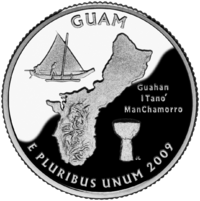
Guam's economy depends primarily on tourism, Department of Defense installations and locally owned businesses. Despite paying no income or excise tax, it receives large transfer payments from the general revenues of the U.S. federal treasury. Under the provisions of a special law by Congress, it is Guam's treasury rather than the U.S. treasury that receives the federal income taxes paid by local taxpayers (including military and civilian federal employees assigned to Guam).
Lying in the western Pacific, Guam is a popular destination for Japanese tourists. Its tourist hub, Tumon, features over 20 large hotels, a Duty Free Shoppers Galleria, Pleasure Island district, indoor aquarium, Sandcastle Las Vegas–styled shows and other shopping and entertainment venues. It is a relatively short flight from Asia or Australia compared to Hawaii, with hotels and seven public golf courses accommodating over a million tourists per year. Although 75% of the tourists are Japanese, Guam receives a sizable number of tourists from South Korea, the U.S., the Philippines, and Taiwan.[31] Significant sources of revenue include duty-free designer shopping outlets, and the American-style malls: Micronesia Mall, Guam Premier Outlets, the Agana Shopping Center, and the world's largest Kmart.
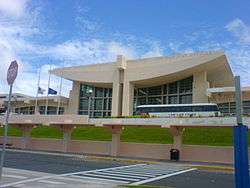
The economy had been stable since 2000 due to increased tourism, but took a recent downturn along with the rest of the global economy. It is expected to stabilize with the transfer of U.S. Marine Corps' 3rd Marine Expeditionary Force, currently in Okinawa, Japan, (approximately 8,000 Marines, along with their 10,000 dependents), to Guam between 2010 and 2015. In 2003, Guam had a 14% unemployment rate, and the government suffered a $314 million shortfall.[32]
The Compacts of Free Association between the United States, the Federated States of Micronesia, the Republic of the Marshall Islands and the Republic of Palau accorded the former entities of the Trust Territory of the Pacific Islands a political status of "free association" with the United States. The Compacts give citizens of these island nations generally no restrictions to reside in the United States (also its territories), and many were attracted to Guam due to its proximity, environmental, and cultural familiarity. Over the years, it was claimed by some in Guam that the territory has had to bear the brunt of this agreement in the form of public assistance programs and public education for those from the regions involved, and the federal government should compensate the states and territories affected by this type of migration. Over the years, Congress had appropriated "Compact Impact" aids to Guam, the Northern Mariana Islands and Hawaii, and eventually this appropriation was written into each renewed Compact. Some, however, continue to claim the compensation is not enough or that the distribution of actual compensation received is significantly disproportionate.
As of 2008 Guam's largest single private sector employer, with about 1,400 jobs, was Continental Micronesia, a subsidiary of Continental Airlines;[33] it is now a part of United Airlines, a subsidiary of Chicago-based United Continental Holdings, Inc.[34] As of 2008 the Continental Micronesia annual payroll in Guam was $90 million.[35]
Transportation and communications
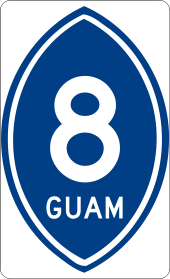
Most of the island has state-of-the-art mobile phone services and high-speed internet widely available through either cable or DSL. Guam was added to the North American Numbering Plan (NANP) in 1997 (country code 671 became NANP area code 671),[36] removing the barrier of high cost international long-distance calls to the U.S. Mainland.
Guam is also a major hub for submarine cables between the Western U.S., Hawaii, Australia and Asia. Guam currently serves 12 submarine cables, with most continuing to China.

In 1899, the local postage stamps were overprinted "Guam" as was done for the other former Spanish colonies, but this was discontinued shortly thereafter and regular U.S. postage stamps have been used ever since. Because Guam is also part of the U.S. Postal System (postal abbreviation: GU, ZIP code range: 96910–96932), mail to Guam from the U.S. mainland is considered domestic and no additional charges are required. Private shipping companies, such as FedEx, UPS, and DHL, however, have no obligation to do so, and do not regard Guam as domestic.
The speed of mail traveling between Guam and the states varies depending on size and time of year. Light, first-class items generally take less than a week to or from the mainland, but larger first-class or Priority items can take a week or two. Fourth-class mail, such as magazines, are transported by sea after reaching Hawaii. Most residents use post office boxes or private mail boxes, although residential delivery is becoming increasingly available. Incoming mail not from the Americas should be addressed to "Guam" instead of "USA" to avoid being routed the long way through the U.S. mainland and possibly charged a higher rate (especially from Asia).
The Commercial Port of Guam is the island's lifeline because most products must be shipped into Guam for consumers. It receives the weekly calls of the Hawaii-based shipping line Matson, Inc. whose container ships connect Guam with Honolulu, Hawaii, Los Angeles, California, Oakland, California and Seattle, Washington. The port is also the regional transhipment hub for over 500,000 customers throughout the Micronesian region. The port is the shipping and receiving point for containers designated for the island's U.S. Department of Defense installations, Andersen Air Force Base and Commander, Naval Forces Marianas and eventually the Third Marine Expeditionary Force.
Guam is served by the Antonio B. Won Pat International Airport, which is a hub for United Airlines. The island is outside the United States customs zone so Guam is responsible for establishing and operating its own customs and quarantine agency and jurisdiction. Therefore, the U.S. Customs and Border Protection only carries immigration (but not customs) functions. Since Guam is under federal immigration jurisdiction, passengers arriving directly from the United States skip immigration and proceed directly to Guam Customs and Quarantine.
However, due to the Guam and CNMI visa waiver program for certain countries, an eligibility pre-clearance check is carried on Guam for flights to the States. For travel from the Northern Mariana Islands to Guam, a pre-flight passport and visa check is performed before boarding the flight to Guam. On flights from Guam to the Northern Mariana Islands, no immigration check is performed. Traveling between Guam and the States through a foreign point, however, does require a passport.
Most residents travel within Guam using personally owned vehicles. The local government currently outsources the only public bus system (Guam Regional Transit Authority), and some commercial companies operate buses between tourist-frequented locations
Ecological issues
Brown tree snake
Believed to be a stowaway on a U.S. military transport near the end of World War II, the brown tree snake (Boiga irregularis) was accidentally introduced to Guam, that previously had no native species of snake. It nearly eliminated the native bird population. The problem was exacerbated because the snake has no natural predators on the island. The brown tree snake, known locally as the kulebla, is native to northern and eastern coasts of Australia, Papua New Guinea, and the Solomon Islands. It is slightly venomous, but relatively harmless to human beings; it is nocturnal. Although some studies have suggested a high density of these serpents on Guam, residents rarely see them. The United States Department of Agriculture has trained detector dogs to keep the snakes out of the island's cargo flow. The United States Geological Survey also has dogs that can detect snakes in forested environments around the region's islands.[37][38]
Before the introduction of the brown tree snake, Guam was home to several endemic bird species. Among them were the Guam rail (or ko'ko' bird in Chamorro) and the Guam flycatcher, both common throughout the island. Today the flycatcher is entirely extinct and the Guam rail is extinct in the wild but bred in captivity by the Division of Aquatic and Wildlife Resources. The devastation caused by the snake has been significant over the past several decades. As many as twelve bird species are believed to have been driven to extinction.[39] According to many elders, ko'ko' birds were common in Guam before World War II.[40]
Other bird species threatened by the brown tree snake include the Mariana crow, the Mariana swiftlet, and the Micronesian starling, though populations are present on other islands, including Rota.[39]
Guam is said to have many more insects and 40 times more spiders than neighboring islands, and the forests are almost completely silent due to lack of birdsong, because the number of birds, their natural predators, are severely diminished.[41][42]
Coconut rhinoceros beetle
An infestation of the coconut rhinoceros beetle (CRB), Oryctes rhinoceros, was detected on Guam on September 12, 2007. CRB is not known to occur in the United States except in American Samoa. Delimiting surveys performed September 13–25, 2007 indicated that the infestation was limited to Tumon Bay and Faifai Beach, an area of approximately 900 acres (3.6 km2). Guam Department of Agriculture (GDA) placed quarantine on all properties within the Tumon area on October 5 and later expanded the quarantine to about 2,500 acres (10 km2) on October 25; approximately 0.5 miles (800 m) radius in all directions from all known locations of CRB infestation. CRB is native to Southern Asia and distributed throughout Asia and the Western Pacific including Sri Lanka, Upolu, Samoa, American Samoa, Palau, New Britain, West Irian, New Ireland, Pak Island and Manus Island (New Guinea), Fiji, Cocos (Keeling) Islands, Mauritius, and Reunion.
Other invasive animal species
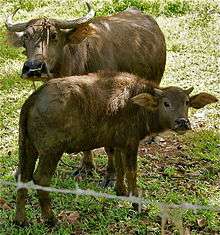
From the seventeenth through nineteenth centuries, the Spanish introduced pigs, dogs, chickens, the Philippine deer (Rusa mariannus), black francolins, and carabao (a subspecies of water buffalo), which have cultural significance. Herds of carabao obstruct military base operations and harm native ecosystems. After birth control and adoption efforts were ineffective, the U.S. military began culling the herds in 2002 leading to organized protests from island residents.[43]
Other introduced species include cane toads imported in 1937, the giant African snail (an agricultural pest introduced during World War II by Japanese occupation troops) and more recently frog species which could threaten crops in addition to providing additional food for the brown tree snake population. Reports of loud chirping frogs native to Puerto Rico and known as coquí, that may have arrived from Hawaii, have led to fears that the noise could threaten Guam's tourism.[44]
Introduced feral pigs and deer, over-hunting, and habitat loss from human development are also major factors in the decline and loss of Guam's native plants and animals.
Threats to indigenous plants
Invading animal species are not the only threat to Guam's native flora. Tinangaja, a virus affecting coconut palms, was first observed on the island in 1917 when copra production was still a major part of Guam's economy. Though coconut plantations no longer exist on the island, the dead and infected trees that have resulted from the epidemic are seen throughout the forests of Guam.[45]
During the past century, the dense forests of northern Guam have been largely replaced by thick tangan-tangan brush (Leucaena leucocephala). Much of Guam's foliage was lost during World War II. In 1947, the U.S. military is thought to have planted tangan-tangan by seeding the island from the air to prevent erosion. Tangan-tangan was present on the island before 1905.[46]
In southern Guam, non-native grass species dominate much of the landscape. Although the colorful and impressive flame tree (Delonix regia) is found throughout the Marianas, the tree on Guam has been largely decimated.
Wildfires
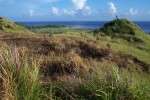
Wildfires plague the forested areas of Guam every dry season despite the island's humid climate. Most fires are man-caused with 80% resulting from arson.[47] Poachers often start fires to attract deer to the new growth. Invasive grass species that rely on fire as part of their natural life cycle grow in many regularly burned areas. Grasslands and "barrens" have replaced previously forested areas leading to greater soil erosion. During the rainy season sediment is carried by the heavy rains into the Fena Lake Reservoir and Ugum River, leading to water quality problems for southern Guam. Eroded silt also destroys the marine life in reefs around the island. Soil stabilization efforts by volunteers and forestry workers (planting trees) have had little success in preserving natural habitats.[48]
Aquatic preserves
Efforts have been made to protect Guam's coral reef habitats from pollution, eroded silt and overfishing, problems that have led to decreased fish populations. (Since Guam is a significant vacation spot for scuba divers, this is important.) In recent years, the Department of Agriculture, Division of Aquatic and Wildlife Resources has established several new marine preserves where fish populations are monitored by biologists.[49] Before adopting U.S. Environmental Protection Agency standards, portions of Tumon Bay were dredged by the hotel chains to provide a better experience for hotel guests.[50][51] Tumon Bay has since been made into a preserve. A federal Guam National Wildlife Refuge in northern Guam protects the decimated sea turtle population in addition to a small colony of Mariana fruit bats.[52]
Harvest of sea turtle eggs was a common occurrence on Guam before World War II. The green sea turtle (Chelonia mydas) was harvested legally on Guam before August 1978, when it was listed as threatened under the Endangered Species Act. The hawksbill sea turtle (Eretmochelys imbricata) has been on the endangered list since 1970. In an effort to ensure protection of sea turtles on Guam, routine sightings are counted during aerial surveys and nest sites are recorded and monitored for hatchlings.
Education
Colleges and universities
The University of Guam (UOG) and Guam Community College, both fully accredited by the Western Association of Schools and Colleges, offer courses in higher education.[53] UOG is a member of the exclusive group of only 76 U.S. land-grant institutions in the entire United States. Pacific Islands University is a small Christian liberal arts institution nationally accredited by the Transnational Association of Christian Colleges and Schools. They offer courses at both the undergraduate and graduate levels.
Primary and secondary schools
The Guam Department of Education serves the entire island of Guam. In 2000, 32,000 students attended Guam's public schools. Guam Public Schools have struggled with problems such as high dropout rates and poor test scores.[54][55] Guam's educational system has always faced unique challenges as a small community located 6,000 miles (9,700 km) from the U.S. mainland with a very diverse student body including many students who come from backgrounds without traditional American education.[56] An economic downturn in Guam since the mid-1990s has compounded the problems in schools.[57]
Before September 1997, the U.S. Department of Defense partnered with Guam Board of Education.[58] In September 1997 the DoDEA opened its own schools for children of military personnel.[59] DoDEA schools, which also serve children of some federal civilian employees, had an attendance of 2,500 in 2000. DoDEA Guam operates three elementary/middle schools and one high school.[60]
Public libraries
Guam Public Library System operates the Nieves M. Flores Memorial Library in Hagåtña and five branch libraries.[61]
Health care
The Government of Guam maintains the island's main health care facility, Guam Memorial Hospital, in Tamuning.[62] U.S. board certified doctors and dentists practice in all specialties. In addition, the U.S. Naval Hospital in Agana Heights serves active-duty members and dependents of the military community.[63] There is one subscriber-based air ambulance located on the island, CareJet, which provides emergency patient transportation across Guam and surrounding islands.[64] A private hospital, the Guam Regional Medical City opened its doors in early 2016.[65]
Film-making
Over the years, a number of films have been shot on Guam, including Shiro's Head (directed by the Muna brothers) and the government-funded Max Havoc: Curse of the Dragon (2004). Although set on Guam, No Man Is an Island (1962) was not shot there, but in the Republic of the Philippines.
Sports
Pacific Games
Guam hosted the Pacific Games in 1975 and 1999. At the 2007 Games, Guam finished 7th of 22 countries and 14th at the 2011 Games.
Association Football
The Guam national football team was founded in 1975 and joined FIFA in 1996. Guam was once considered one of FIFA's weakest teams, and experienced their first victory over a FIFA-registered side in 2009, when they defeated Mongolia in the East Asian Cup.
Guam entered the 2018 FIFA World Cup qualification Group D. Guam hosted qualifying games on island for the first time in 2015. During the qualifying round, Guam clinched their first FIFA World Cup Qualifying win by defeating Turkmenistan. Since then, the team has experienced moderate success in the Qualifying Round with a record of 2-1-1.[66]
The national team plays at the Guam National Football Stadium, which has a capacity of 1,000. The men's national football team are known as the "matao" team. Matao is the definition of highest level or "noble" class; the matao team have done exceptionally well under the head coach Gary White.
The top football division in Guam is the Guam Men's Soccer League. Rovers FC and Guam Shipyard are the league's most competitive and successful clubs, both have won nine championships in the past years.
Swimming
In the 2012 Summer Olympics in London, Pilar Shimizu competed for Guam and placed 42nd in the breaststroke competition.
Rugby union
Guam is represented in rugby union by the Guam national rugby union team. The team has never qualified for a Rugby World Cup. Guam played their first match in 2005, an 8–8 draw with India. Guam's biggest win was a 74–0 thrashing of Brunei in June 2008.
Mixed Martial Arts
UFC fighter Jon Tuck fights out of Guam, who boasts a professional record of 9 wins and 3 losses, with three of those wins whilst with the UFC.
See also
- Index of Guam-related articles
- List of National Register of Historic Places in Guam
- List of people from Guam
- Mariana Islands
- Mariana Trench
- Micronesia
- Outline of Guam
- Voting in Guam
References
- 1 2 3 4 5 6 7 "Australia-Oceania :: Guam (Territory of the US)". The World Factbook. Central Intelligence Agency. Retrieved 26 August 2015.
- ↑ Filling Gaps in the Human Development Index, United Nations ESCAP, February 2009
- ↑ "U.S. Territories". Archived from the original on February 9, 2007. Retrieved 2007-02-09.." DOI Office of Insular Affairs. February 9, 2007.
- ↑ "DEFINITIONS OF INSULAR AREA POLITICAL ORGANIZATIONS.". Archived from the original on July 21, 2011. Retrieved 2007-11-14. Office of Insular Affairs. Retrieved October 31, 2008.
- ↑ Non-Self-Governing Territories - Official U.N. Website
- ↑ War Restitution Act : hearing before the Subcommittee on Insular and International Affairs of the Co... |National Library of Australia. Catalogue.nla.gov.au (September 20, 1994). Retrieved June 13, 2012.
- ↑ "Statement of David B. Cohen Deputy Assistant Secretary of the Interior for Insular Affairs Before the House Committee on Resources Regarding the Report of the Guam War Claims Review Commission |July 21, 2004." Office of Insular Affairs. Retrieved September 19, 2012.
- ↑ Higuchi, Wakako (2001). "The Japanisation Policy for the Chamorros of Guam, 1941–1944" (PDF). The Journal of Pacific History. 36 (1): 19–35. doi:10.1080/00223340120049424.
- ↑ "Guam police arrest suspect in memorial theft". Marine Corps Times. Associated Press. July 7, 2007. Retrieved April 5, 2010.
- 1 2 3 4 5 Rogers, Robert F. (1995). Destiny's Landfall: A History of Guam. Honolulu: University of Hawaii Press. ISBN 978-0-8248-1678-0.
- 1 2 3 4 5 6 7 8 9 10 11 12 13 14 15 16 17 18 19 20 21 22 23 24 25 26 27 28 29 30 31 32 Carano, Paul; Sanchez, Pedro C. (1964). A Complete History of Guam. Tokyo: Charles E. Tuttle Company. OCLC 414965.
- 1 2 Nowell, Charles E. (1962). Magellan's voyage around the world; three contemporary accounts. Evanston: Northwestern University Press. OCLC 347382.
- 1 2 3 4 Rottman, G. (2004) Guam 1941 & 1944: Loss and Reconquest. Oxford: Osprey Publishing, ISBN 978-1-84176-811-3
- ↑ Mabini, A., 1969, The Philippine Revolution, Republic of the Philippines, Dept. of Education, National Historical Commission
- ↑ Werner Gruhl, Imperial Japan's World War Two, 1931–1945, Transaction Publishers, 2007 ISBN 978-0-7658-0352-8
- ↑ Kristof, Nicholas D. (September 26, 1997). "Shoichi Yokoi, 82, Is Dead; Japan Soldier Hid 27 Years". The New York Times.
- ↑ Rogers, Robert F. (1995). Destiny's Landfall: A History of Guam. Honolulu: University of Hawaii Press.
- ↑ Curry, Tom (May 28, 2008). "Nominating, but not voting for president: Clinton-Obama struggle spotlights Guam, American Samoa, Puerto Rico". NBC News. Retrieved August 19, 2016.
- ↑ "Geography of Guam". Official site of Guam, April 19, 2014. Retrieved April 19, 2014 from http://ns.gov.gu/geography.html.
- ↑ "Home page of the Anahatan volcano". USGS-CNMI, November 8, 2007. Retrieved November 8, 2007 from http://hvo.wr.usgs.gov/cnmi/.
- ↑ "Climatological Report". National Weather Service. February 26, 2014. Retrieved February 26, 2014.
- ↑ "National Weather Service Dedicated Forecast Office in Typhoon Alley". US NOAA NWS. April 27, 2000. Retrieved August 19, 2012.
- ↑ "Guam Catastrophe Model". Risk Management Solutions. Retrieved June 16, 2007.
- ↑ "Winds". PacificWorlds.com. Retrieved June 16, 2007.
- ↑ "NOWData – NOAA Online Weather Data". National Oceanic and Atmospheric Administration. Retrieved November 17, 2012.
- ↑ "Climatological Information for Guam, Pacific Islands, United States". Hong Kong Observatory. Retrieved November 17, 2012.
- ↑ "Puntan dos Amantes". NPS: Explore Nature. The US National Park Service. Retrieved September 9, 2012.
- ↑ Military: Naval Air Station, Agana (Tiyan). GlobalSecurity.org. Retrieved 2010-02-19.
See also List of United States Navy installations#Guam. - ↑ McAvoy, Audrey (February 25, 2010). "EPA sharply criticizes military's Guam plan". Boston Globe. Retrieved December 28, 2010.
- ↑ Parrish, Karen (July 20, 2012). "Carter: Guam Central to Asia-Pacific Strategy." American Forces Press Service.
- ↑ "Guam Visitors Bureau Tourist Statistics". Archived from the original on August 27, 2007. Retrieved 2007-08-27.. visitguam.org
- ↑ "2004 Guam Yearbook" (PDF). Retrieved July 19, 2007.
- ↑ Kerrigan, Kevin. "Guam Will Be The Pacific Hub for Merged Airlines". Retrieved August 20, 2016.. Pacific News Center (May 5, 2010). Retrieved October 5, 2010. "Continental Micronesia is Guam's single largest employer. About 1400 jobs here on dependent on the airline."
- ↑ "Company Information." (Archive) United Continental Holdings. Retrieved November 16, 2012.
- ↑ Blair, Chad (May 30, 2008). "'Air Mike' a rare bright spot in local aviation." Pacific Business News.
- ↑ J. N. Deak (August 5, 1996). "PL-NANP-004" (PDF). North American Numbering Plan Administration. Retrieved October 12, 2010.
- ↑ Fritts, T.H.; D. Leasman-Tanner (2001). "USGS: The Brown Tree Snake on Guam". Retrieved July 28, 2007.
- ↑ Vice, Daniel S.; Engeman, Richard M. (2000). "Brown Tree Snake Discoveries During Detector Dog Inspections Following Supertyphoon Paka". Retrieved June 7, 2009.
- 1 2 John M. Marzluff; Tony Angell (2007). In the Company of Crows and Ravens. Yale University Press. ISBN 0-300-12255-1.
- ↑ Rodda, Gordon H.; Fritts, Thomas H. (1992). "The Impact of the Introduction of the Colubrid Snake Boiga irregularis on Guam's Lizards". Journal of Herpetology. 26 (2): 166–174. doi:10.2307/1564858. JSTOR 1564858.
- ↑ Rogers, H.; Hille Ris Lambers, J.; Miller, R.; Tewksbury, J. J. (2012). Siepielski, Adam, ed. "'Natural experiment' Demonstrates Top-Down Control of Spiders by Birds on a Landscape Level". PLoS ONE. 7 (9): e43446. doi:10.1371/journal.pone.0043446. PMC 3436874
 . PMID 22970126.
. PMID 22970126. - ↑ http://www.futurity.org/spiders-infest-guam-after-native-birds-disappear/
- ↑ "More Than 100 Protest Guam Carabao Cull". AnimalRights.net. October 15, 2003. Archived from the original on April 28, 2005. Retrieved June 15, 2007.
- ↑ Worth, Katie (February 28, 2004). "Two Male Coqui Frogs Found in Guam". Retrieved July 19, 2007.
- ↑ Hodgson, R. A. J.; Wall, G. C.; Randles, J. W. (1998). "Specific Identification of Coconut Tinangaja Viroid for Differential Field Diagnosis of Viroids in Coconut Palm" (PDF). Phytopathology. 88 (8): 774–781. doi:10.1094/PHYTO.1998.88.8.774. PMID 18944882. Archived from the original (PDF) on June 14, 2007. Retrieved June 16, 2007.
- ↑ Stafford, William Edwin (1905) Useful Plants of Guam
- ↑ "Territory of Guam Fire Assessment January 2004" (PDF). Archived from the original on March 24, 2009. Retrieved 2009-03-24., pp. 6–7, guamforestry.org
- ↑ National Park Service. "Fire and Guam". United States Department of the Interior. Archived from the original on December 13, 2007. Retrieved June 16, 2007.
- ↑ Brown, Valerie. "Guam's Marine Preserves". Pacific Daily News. Retrieved June 16, 2007.
- ↑ "Management of Contaminated Harbor Sediments in Guam" (PDF). EPA Guam Report.
- ↑ Packbier, Paul E.R. "Tumon Bay – Engineering a Better Environment". Directions Magazine; June/July 1996. Retrieved October 19, 2011.
- ↑ Holmes III, Rolston (2001). "Environmental Ethics in Micronesia, Past and Present, Part II—Guam Today: Still "on the Edge." Colonial Legacy and American Presence". International Society for Environmental Ethics Newsletter. 12 (3). Retrieved June 16, 2007.
- ↑ "Politics Trumps Performance in Guam School System". Pacific Islands Report. June 15, 2006. Retrieved June 16, 2007.
- ↑ "Merrow Report: First to Worst". Archived from the original on August 10, 2007. Retrieved November 8, 2007.
- ↑ "State Comparisons". 1996. Archived from the original on July 13, 2007. Retrieved November 8, 2007.
- ↑ Grace, Ted; Teresita Salos (1966). "Guam's Education Marches On". Peabody Journal of Education. 44 (1): 37–39. doi:10.1080/01619566609537383.
- ↑ "An act to establish a guam parental school choice program". 1999. Retrieved November 8, 2007.
- ↑ "Rats, other problems face Guam schools." Pacific Stars and Stripes. October 3, 1993.
- ↑ Guam School to Be Renamed in Honor of NASA Astronaut William McCool |SpaceRef – Your Space Reference. SpaceRef (August 21, 2003). Retrieved June 13, 2012.
- ↑ "District and School Contact Information". pac.dodea.edu. Retrieved May 10, 2006.
- ↑ . gpls.guam.gov
- ↑ Welcome to the official Guam Memorial Hospital Authority Website! – Tonyt. Gmha.org. Retrieved June 13, 2012.
- ↑ U.S Naval Hospital Guam. United States Navy
- ↑ "Guam's CareJet Program Resumes Service". Air Medical Net. September 10, 2012. Retrieved April 21, 2016.
- ↑ Sablan, Jerick (January 4, 2016). "No. 5: Guam Regional Medical City opens". Pacific Daily News. Retrieved April 21, 2016.
- ↑ FIFA.com. "2018 FIFA World Cup Russia™ - Qualifiers - Asia - FIFA.com". FIFA.com. Retrieved 2015-09-12. line feed character in
|title=at position 29 (help)
External links
- Guam.gov – Official Government Website
- Guampedia, Guam's Online Encyclopedia
- The Insular Empire: America in the Mariana Islands, PBS documentary film website.
- "Guam". The World Factbook. Central Intelligence Agency.
- U.S. Census Bureau: Island Areas Census 2000
- Guam at DMOZ
- Portals to the World: Guam from the U.S. Library of Congress.
 Wikimedia Atlas of Guam
Wikimedia Atlas of Guam
Coordinates: 13°30′N 144°48′E / 13.500°N 144.800°E
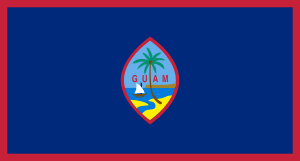


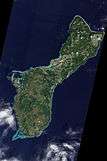
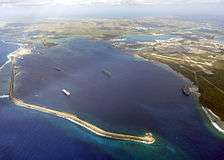
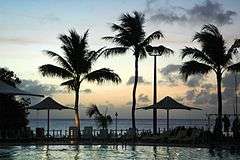
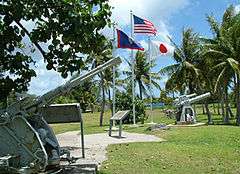



.svg.png)
